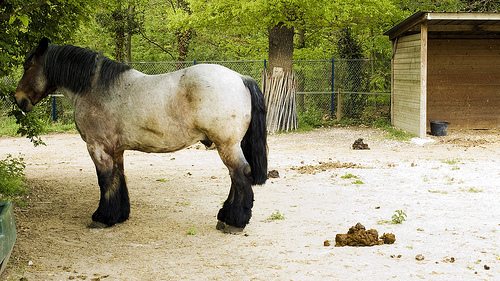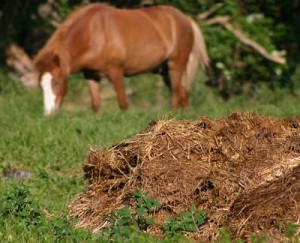Horse Manure Compost

Gardening Question from Dave:
I have a very reliable and steady source of horse manure (1 quarter horse, 1 draft horse and 1 shetland pony) and an equally reliable source of pine needles. Using the old compost addage “something green and something brown” can I combine the two to create useful compost?
Answer from Pat:
You are very lucky to have a steady supply of horse and pony manure, but I would not mix pine needles with the manure if I were you. This actually won’t create the correct green/brown mix (Ie: carbonaceous mixed with nitrogenous.) Straight horse manure, alone, (unmixed with anything) is close to the correct green/brown ratio already. One can just pile it on the ground and let it age and once aged it can then be combined into garden soil. In some cases stable bedding is included with the manure. Usually there is enough liquid nitrogenous stuff (horse urine) included with the bedding to sufficiently rot it in time, but this would not apply to pine needles. The needles most likely wouldn’t rot.
Since we are having such good rains right now it’s an ideal time to spread the clean manure directly onto the ground over the roots of plants you want to mulch and gradually feed. Let it age right there and dig it in in spring prior to planting. By spreading it right on top of the ground all the goodness of the manure will be washed down into the ground by these rains and not wasted on the ground under the manure pile. It also causes less runoff this way since it is less concentrated and there is more ground to hold the nutrients in the soil instead of letting them wash away. Spread the manure on top of any ground that you want to improve with organics, such as a vegetable garden or flowerbed or over the roots of fruit trees or ornamentals. There is no reason to add the pine needles to the manure.
In my book I describe a compost made from alfalfa and manure layered together. This combination is different from one using pine needles, since it makes a great quick compost which is ready in about two months. (As soon as it cools down and you can no longer see what went into it, it is ready.) You can then use it as mulch all over the garden or dig it right into the ground. The reason this works so well and makes such a nutritious compost so quickly is because alfalfa is not carbonaceous but green or nitrogenous waste. In fact alfalfa is a major source of nitrogen when used alone as fertilizer and it rots quickly in the ground. Pine needles, by contrast, have no nitrogen in them. They are pure carbonaceous material, and they have a hard coating and texture that means they take much longer to disintegrate. (It should be noted, however, that the needles of certain pine trees, such as Aleppo Pines, are smaller and thinner and rot quicker than those of other pines such as Torrey pine trees, whose needles take months or even years to rot.) Composting pine needles is usually a long process and they are also highly acid. The best use for pine needles in a garden is as a long-lasting mulch covering the root zones of acid-loving plants, such as azaleas and camellias. Some people like to make a separate compost pile for pine needles, simply leaving them piled up until they age. Then they can even be used in soil mixes for acid loving plants. Other folks use them on garden paths in woodland areas under trees and shrubs, or at the backs of wide flower beds, but always on top of the ground. They make a very clean, good looking path cover.
Photo by Tavallai 



Thanks for this post! Very timely for me as I have been considering reaching out to our local stable for manure. Would you give the same advice for chicken manure -spreading directly and letting it age on the spot its going to nourish?
Thanks for you kind comment. There is no reason, not to age the chicken manure on top of the ground just as I suggested for horse manure, but it’s important to spread it far more thinly and let it sit longer before combining it with soil. Chicken manure is hotter than horse manure which is why it needs to be aged longer than horse manure before combining it with garden soil. Always age chicken manure three months before combining it with garden soil. Chicken manure has an approximate N-P-K (i.e.: Nitrogen, phosphorus, and potassium) formula of 15-2-0 and with that much nitrogen in it, needs 3 months aging before you can safely combine it with garden soil, but putting it on top of the ground is a different matter. Raw chicken manure combined with garden soil or dug into the ground will burn plants. However, it’s fine to age it on top of the ground where you intend to dig it in later if you are careful to use small quantities as you would with any bagged fertilizer and then follow up with plenty of water. Think of it not as a mulch but truly an organic fertilizer, and actually a very good one. It’s also a bit smelly. Horse manure will smell for a day or two after spreading, but after that any odor dissipates. Chicken manure can smell longer and may bring flies. It can also stick to your shoes if you accidentally step on it. On the other hand it does not contain weed seeds as horse manure frequently does.
I spent my early teen years on a chicken farm in Bucks County Pennsylvania during the Second World War and we spread our chicken manure thinly straight onto our fields in early spring or fall and let it age right there instead of on a manure pile, but there were plentiful rains and snow and it was a full three months from spreading of manure to plowing and harrowing the soil by which processes the manure would be combined with the soil. Everything grew wonderfully well since chicken manure is an excellent fertilizer. Had we dug the fresh manure into the ground then our plants would have been burned. Aged chicken manure is also an excellent lawn fertilizer but if you were to spread it on wet grass or over dry grass with bone dry roots you could burn your lawn. The soil of a lawn needs to be moist and the grass leaves dry before spreading aged chicken manure safely onto a lawn and then you must water it in right after spreading it.
I got some aged manure that was mor like dirt and smelled of dirt not poo i used it for dirt instead….was that a bad idea has some small chunks but mostly looks like dirt
Sorry but I have no way to know the quality of any manure or soil amendment you purchased, so how am I able to say whether it was safe or not to use it as a replacement for garden soil? I can say however, that since it was evidently cool and not hot, and also if it did not contain any harmful ingredients such as salt or un-rotted organic matter, it should be okay. Regarding the wording of your question, the primary definition of the word “dirt” is “grime or filth”. The primary definition of the word “soil” is “the upper layer of earth in which plants grow.” I think when you wrote the word “dirt” you actually meant to be saying “soil”.